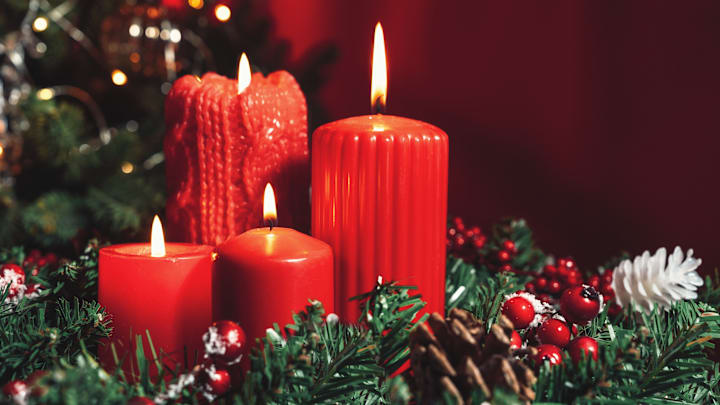People around the world celebrate Advent, the period of time each December where Christians prepare for Christmas and wait for the second coming of Jesus Christ. But if your knowledge of Advent begins and ends with Advent calendars—those Christmas-themed calendars with 24 perforated windows—read on to learn 10 things about Advent.
- Advent originated as a period of fasting.
- Its start date may vary.
- Advent is a time of sorrow and joy.
- Observants light candles in an Advent wreath.
- Violet is a popular color during Advent.
- Chocolate Advent calendars aren’t the only ones with little prizes.
- 7. The third Sunday of Advent is a day to rejoice.
- Some observants think it’s too early for Christmas music.
- Sundays are important.
- Most Christians no longer fast during Advent.
Advent originated as a period of fasting.

Advent, from the Latin word adventus, meaning “arrival,” refers to the arrival of Jesus Christ. Although scholars aren’t sure exactly when Christians began observing Advent, we do know that monks in the 5th century CE began fasting thrice weekly in November, either to prepare for Christmas or Epiphany, during which new Christians were baptized each year. Similar to Lent, in which Catholics fast and pray for 40 days before Easter, Advent encourages Christians to fast so they can focus on repentance and prayer.
Its start date may vary.

In most Western churches, Advent begins on the Sunday four weeks before Christmas Day. So depending on the calendar, Advent may start at the end of November rather than beginning of December in some years. In the Eastern Orthodox Church, Advent is called the Nativity Fast and usually begins in mid-November, so it lasts approximately six weeks instead of four.
When does Advent begin in 2025? |
|---|
Advent will start on Sunday, November 30, 2025. |
Advent is a time of sorrow and joy.

During Advent, devout Christians take the time to pray, reflect on the past year, and mourn for the sin and evil in the world. Although Advent is a time of sorrow, it’s also an opportunity to express hope. Christians prepare for new beginnings, look forward to the second coming of Christ, and renew their faith.
You May Also Like ...
- Why Does Advent Calendar Chocolate Taste Different?
- A Brief History of Advent Calendars
- The Origins of 12 Christmas Traditions
Add Mental Floss as a preferred news source!
Observants light candles in an Advent wreath.

Representing hope and everlasting light, candles have been traditional symbols of Advent for centuries. On the four Sundays prior to Christmas, most churches light an Advent candle, with each candle corresponding to an anecdote from the Bible. Some Christians also light Advent candles in evergreen wreaths, called “Advent wreaths.” Depending on the denomination of Christianity, believers may light a fifth candle inside the wreath on Christmas Eve or Christmas Day to represent the birth of Christ.
Violet is a popular color during Advent.

While green and red are typically associated with Christmas, the period leading up to December 25 is all about purples or violets. The candles in advent wreaths are usually violet or purple, churches are decorated with violet, and priests may wear the color in the weeks before Christmas. To Christians, purple represents repentance and fasting, though some denominations use blue or pink instead of violet.
Chocolate Advent calendars aren’t the only ones with little prizes.

Most advent calendars are simple cardboard affairs, and each opened window reveals an illustration of a Christmas-related item such as a reindeer or a stocking. But if you want to inject the countdown to Christmas with more anticipation and excitement, buy an advent calendar filled with chocolate, candy, or other sweet treats. Don’t have a sweet tooth? There are also advent calendars containing everything from 24 LEGO pieces to 24 diamonds.
7. The third Sunday of Advent is a day to rejoice.

On the third Sunday of Advent, called “Gaudete Sunday,” Christians take a break from repenting to celebrate Christ’s imminent arrival. Churches use rose-colored candles and decorations, and the clergy preach about joy, redemption, and blessings. Christians may pray and reflect on the things for which they’re grateful.
Some observants think it’s too early for Christmas music.

Although stores and radio stations begin blasting Christmas songs long before Thanksgiving, devout Christians don’t celebrate Advent by singing Christmas music. Instead, they sing Advent-specific hymns, such as "O Come, O Come, Emmanuel," and they postpone the Christmas tunes until Christmas Eve.
Sundays are important.

On each of the four Sundays of Advent, most churches focus on a specific religious topic such as the Prophets, the Messiah, or John the Baptist. Clergy may give sermons and light candles, and Christians spend time both remembering the first coming of Christ and anticipating His second coming. Because Sundays are so important during Advent, some churches don’t allow funeral masses on those days.
Most Christians no longer fast during Advent.

Today, some devout Christians still fast during Advent, while others simply avoid consuming certain foods such as meat, dairy, or desserts. Still other Christians focus on praying and repentance rather than fasting. In general, current members of Eastern Orthodox churches are more likely to fast than members of Western churches.
A version of this story originally ran in 2016; it has been updated for 2025.
